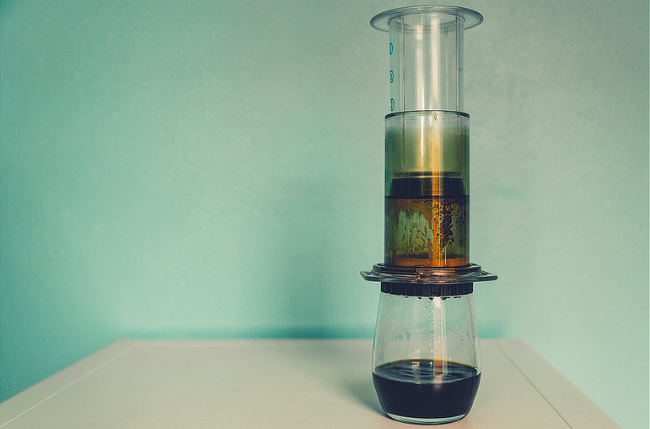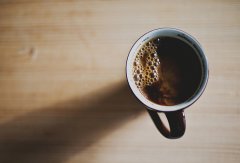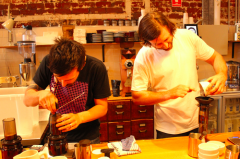Talking about Coffee: Philharmonic pressed Coffee (part I)

For professional baristas, please follow the coffee workshop (Wechat official account cafe_style)
"in fact, there are many similarities between making film and making coffee: you have to adjust the water temperature and school time at the same time. The photo is fine, and the effect can be controlled immediately, while the coffee can be tasted only after brewing. If it doesn't taste good, we can only review it next time. " Today's guests are photography lovers. Obsessed with the traditional dark room technology, he recently began to make his own coffee.
Soaking coffee brewing tool
"I work in an office building during the day, so it's troublesome and fragile to wash pots. This giant syringe, made of plastic, is light and heat-resistant, and has become my secret weapon for making a good cup of coffee. " He took out a grayish-black container with a scale on the surface from the camera bag full of film and said, "it's a pity that there is no aeropress competition in Hong Kong, otherwise I will sign up!"
Coffee brewing tools named after the word "press" are French Press and aeropress. The former has a long history, while the latter was invented by Aerobie in 2005. Anyone who has used to press the pot to make coffee knows that the hole in the filter is very thick. The so-called pressure is actually more like pushing Shau Kei down to separate the coffee powder from the liquid. So the bottom of the French Press coffee cup will sink with fine powder, resulting in excessive extraction. On the contrary, because the Philharmonic pressure is separated by much thinner filter paper, it takes considerable effort to extract coffee, which is more in line with the artistic conception of "pressure".
I introduced the standard usage of aeropress to another guest: "Philharmonic pressure is an immersion coffee brewing tool (immersion brewing): put filter paper on the bottom of the syringe, pull up the piston, add the ground coffee powder, pour hot water and stir, and press the piston down after tens of seconds. You can make a cup of coffee in a few simple steps. "
The concentration depends on powder and water.
"Patrick, stop reciting the instructions, will you?" The photographer said. "if it were that simple, there would be no WAC (World Aeropress Championship). What's the difference between the champion and the runner-up? Stir continuously for 45 seconds by typing the figure 8, and first turn the syringe upside down, stirring counterclockwise 3 times every 15 seconds. There are all kinds of cooking methods circulating on the Internet. I like the event best with gold, silver and bronze aeropress as trophies. How interesting. "
"what affects the taste of a cup of tea the most? The temperature of the water? How much tea? Soak time? Or how many times do you stir in what direction? " I explained. "the advantage of Philharmonic pressure is that it is easy to use. Because of the soaking method, the basic factors that have the greatest influence on the concentration (brew strength) are the amount of powder, the amount of water, the temperature of water, the thickness of powder and the soaking time. When you blindly repeat a certain trick and don't know the reason, it's easy to get lost. "
You are a real enthusiast. The experimental demonstration that this gentleman will come back later has made me take a fresh look at the versatility (versatility) of Philharmonic pressure.
Important Notice :
前街咖啡 FrontStreet Coffee has moved to new addredd:
FrontStreet Coffee Address: 315,Donghua East Road,GuangZhou
Tel:020 38364473
- Prev

Why is the cup tester's cup spoon either gold or silver? Cup spoon is also fastidious?
For the exchange of professional baristas, please follow the coffee workshop (Wechat official account cafe_style) nearby cup tester exam. After greeting the last guests who were left alone, I set up a bar and listed 6 groups of 5 bowls of bearer coffee for colleagues preparing for the exam. In the pocket is a small bag of specially prepared defective beans. Secretly put it into some bowls later, hoping they can confirm it.
- Next

Talking about Coffee: Philharmonic Coffee (part two)
Professional barista communication please follow the coffee workshop (Wechat official account cafe_style) you are lucky to meet me who is serious outside the dark room. In order to cooperate with photography enthusiasts' experiments, colleagues put hot water bottles, coffee cups and aeropress on the bar in the store. If you make coffee in the office, these devices are enough. If you pay attention to it, it can be matched with electronic pounds and
Related
- Beginners will see the "Coffee pull flower" guide!
- What is the difference between ice blog purified milk and ordinary milk coffee?
- Why is the Philippines the largest producer of crops in Liberia?
- For coffee extraction, should the fine powder be retained?
- How does extracted espresso fill pressed powder? How much strength does it take to press the powder?
- How to make jasmine cold extract coffee? Is the jasmine + latte good?
- Will this little toy really make the coffee taste better? How does Lily Drip affect coffee extraction?
- Will the action of slapping the filter cup also affect coffee extraction?
- What's the difference between powder-to-water ratio and powder-to-liquid ratio?
- What is the Ethiopian local species? What does it have to do with Heirloom native species?

